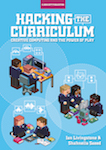10 ways computer games can help your children at school
Posted on 15th May 2017 in Technology, John Catt Publications
Shahneila Saeed, Head of Education at UKIE and co-author of new book Hacking the Curriculum: Creative Computing and the Power of Play, argues that computer games have an important role to play in education...
Playing games and studying are two things that often are not perceived to go together unless it's PE lessons. Playing computer games is generally seen to be something that you simply cannot do at the same time as studying. Why? Well, when we try to visualise a student at work, we may picture them in a variety of ways; reading a book, making notes, talking to friends or asking questions from their teacher. Whatever the mental image it is highly unlikely that playing computer games will appear in that picture. We tend to associate playing computer games with recreation time, time that perhaps some people would argue would be better spent outdoors.
But computer games do have value and a place in education, and they’ve been around for longer than you might think. Since computers first came into schools in the 80s, computer games have been a common way to introduce students to digital literacy skills at the time. Later, Smile Maths produced a suite of games to introduce students to a range of mathematical principles, from teaching co-ordinates to angles these mini games kept many a student entertained.
More recently with the revamped computing curriculum in place the growth of educational games has yet again increased. Games such as Lightbot and Code Combat are designed to teach students programming skills. Other games such as Minecraft are seen as ideal environments for students to explore a range of cross-curricular concepts. Other companies such as Classcraft and Education City also use games to help introduce students to a range of concepts and ideas.
While educational games might seem more ‘palatable’ the truth is video games more broadly have great educational value. Games such as Rollercoaster Tycoon, Angry Birds and Plants Vs Zombies all contribute to the academic and cognitive growth of the student. There are benefits also with games such as Mario Kart, Unchartered and any number of the broader and more popular video game titles.
How? Here are 10 ways that computer games can help your children:
1. It’s a well recorded fact that the use of computer games help to improve engagement and motivation in lessons. ‘Play’ is an intrinsic human behaviour and computer games embody that for the modern digital student in a way that many other classroom resources cannot.
2. Children play games at home, by using them in the classroom we are more likely to encourage continued learning beyond the classroom. For example, setting a homework which requires the student to attempt a particular game level is more likely to get done rather than setting a simple Q&A exercise. In fact, it’s quite likely that the student will attempt more than one level within that timeframe.
3. Developmental psychologists and EYFS teachers recognise the power of play and recommend learning through play for young children. In fact, it’s something Ofsted will look for when they inspect nursery and reception classes. Primary school teachers teaching Key Stage 1 (Reception class to Year 2) do this extremely well in fact. Almost everything they do is turned into a playful activity. The pupils will not only learn the concepts intended but they will have learnt it within context and have a great deal of fun while doing so. Unfortunately, we don’t seem to do enough of this as students get older and its practically non-existent in secondary schools.
4. Play makes abstract concepts concrete, therefore making them easier to understand, particularly (but not exclusively to) younger learners. Computer games are brilliant at presenting a virtual world that transports the player into a new reality. Within this world you can manipulate everything from your environment to your own and others abilities. It’s a customised world that allows you to explore ideas and concepts that would otherwise be almost impossible to do so. For example, using Minecraft to walk and explore your way around the Central Processing Unit of a computer, or playing Assassin's Creed will enable you to explore ancient cities in a way that you simply cannot do so otherwise. With the advent of VR the possibilities are only increasing, with students now able to walk in space, explore the human bloodstream or the inside of a volcano. Computer games help bring things to life. Rather than simply reading or listening to a stream of words, computer games allow students to see, touch, explore and manipulate environments that they would have been unable to do so otherwise.
5. Computer games allow players to become producers rather than consumers. This is an essential skill for our students to develop if they are to be adequately prepared for the world of work tomorrow. Simply put, children learn by doing and video games can help students put skills and concepts into practice to embed them more firmly. Using computer games and play more broadly enables us to put students into the driver’s seat, giving them direct responsibility over their own learning. It’s methodologies such as this that help students develop essential computational thinking and other key 21st Century skills.
6. Computer games help the player think like a scientist. In any engaging game, there will be a problem that needs to be solved, a goal that needs to be achieved. Accomplishing the goal or solving the problem won’t be easy, there will be several obstacles along the way. But that’s part of the fun, testing different strategies and ideas before ultimately arriving at the solution that works. Being able to hypothesise, test and evaluate their findings sensibly and objectively is something all teachers want their students to develop. So, it goes without saying that computer games can help to develop problem solving and computational thinking skills
7. Play has been found to have strong links to help develop creativity and imagination amongst children.
8. Computer games support collaboration, for example, the growing sector of esports requires people to communicate effectively in teams to strategise and ultimately win the game.
9. Computer games help to lower consequences of failure. They encourage players to take risks, explore and try new things. Think about it. When you play a game, if you fail a level you will try again and again in order to finally achieve it. However, that doesn’t naturally translate to our approach with our studies. If we fail at a test, we can become demotivated, students may often feel like they have ‘one shot’ at this and no more. Computer games help students to deal with failure, to learn from it, pick themselves up and try again.
10. Playing games enables us to develop mastery and technical prowess over related skills. Children who play Minecraft for example, will watch YouTube videos, read magazines and articles to learn new skills and techniques to create a better world. They want to learn, because they want to get better at the game they are playing!
Computer games and the use of play more broadly can help develop a love of lifelong learn amongst students if used effectively in education. They encourage students to test out new ideas, to pick themselves up from their previous failure and try again, and to be more creative in their approach. In addition, a range of studies have shown that computer games have been associated with numerous health and cognitive benefits including:
- They can help to address autism
- Help you destress
- Help you make faster decisions
- Improvement in attention
- Improves hand-eye coordination
Hacking the Curriculum: Creative Computing and the Power of Play explores the benefits of using play in the classroom and outlines practical strategies to help teachers cultivate a culture of creativity in their schools. From lesson ideas, to practical games that teachers can play as well as links to wider initiatives, the book brings together the key learnings across the disciplines to argue that students should be allowed to play in the classroom.

This article first appeared in the summer term issue of Academy magazine. To read the full issue, go to www.academymag.co.uk